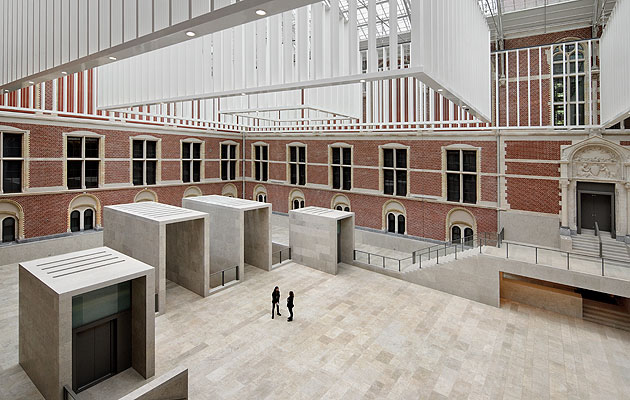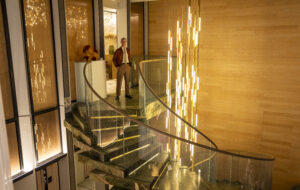|
|
||
|
This article first appeared in our January 2014 issue, which included all the winners of last year’s Icon Awards. Read about the nominees for this year’s award. The winner will be announced on 4 December and be interviewed for our upcoming Awards issue Spanish firm Cruz y Ortiz’s restoration of the Netherlands’ largest museum shows the grandeur of 19th-century romanticism in a new light Since Amsterdam’s Rijksmuseum reopened in April 2013, well over a million visitors have poured back in to examine the Netherlands’ largest collection of art and artefacts, including paintings by Vermeer, Rembrandt and others of the Dutch Golden Age. A titanic example of late 19th-century romantic eclecticism, designed by Pierre Cuypers and opened in 1885, its painstaking restoration, which has taken more than a decade, has been the work of Seville-based architect Cruz y Ortiz. “We are extremely happy!” says the architect’s co-founder Antonio Ortiz. “The building has been very well received by everybody – by the public, the museum staff, people in Amsterdam, in the Netherlands. I don’t remember any of our other buildings being so unanimously appreciated.” He has reason to be pleased, as it was a truly epic job. It lasted 13 years from the competition to the opening, meant setting up a satellite office in Amsterdam, and involved a number of new buildings being built on the grounds. Even now it is not quite finished, as the temporary wing that housed fragments of the collection during the works is being renovated. To have pleased so many, working on an entire country’s cultural pride and joy, is no mean feat. Like so many huge cultural buildings of that era, over the years the Rijksmuseum had been put through all manner of reorganisations and refurbishments, and had accreted a number of unsympathetically executed exhibition spaces within its walls and courtyards. Cruz y Ortiz stripped back the interiors to their original proportions, in many cases restoring them to the original decorative schemes (with Jean-Michel Wilmotte providing exhibition design services), and maintained the internal vaulted route that runs through the centre of the building. The two courtyard spaces were cleared of their clutter and encrustations, sunk down so they could be linked together beneath the centre of the building – no mean feat in a city whose ground is as wet as Venice – and turned into open spaces for a contemporary museum programme (shops and cafes) and circulation.
“I think the architecture has modestly contributed to the success,” Ortiz says. “The building had been so badly treated during the 20th century, just reopening the corridors and putting things in the right place was something people had to notice, because the perception of the building is completely different.” Unlike Norman Foster’s British Museum courtyard extension, where the rightfully celebrated new roof was let down by some ghastly mock-classical detailing at ground level, not to mention the highly reverberant acoustics, the Rijksmuseum courtyards have managed a more successful juxtaposition with their host building. Quality materials, in colours complementing the polychromatism of the original, are laid out in a contemporary but proportionally controlled design, while at a higher level, a series of suspended acoustic baffles mimic the structural rhythms of the iron and glass roof above. “The decisions we made for the new courtyards and the way in which our architecture mixed with the existing was also part of the success, I’d like to think,” Ortiz says. Perhaps the time has come that the overblown architecture of the late 19th-century period can be approached with seriousness. After the modernist era, when it was treated with suspicion – too dishonest, too tainted by imperialism – and after it was revived ineptly for so long by the postmodernists, we’re now able to see confections such as the Midland Hotel in London (recently restored) or the Palais de Justice in Brussels (under restoration) in a new light, as grandiose and flawed Gesamtkunstwerks from a rapidly changing society. A modern, yet sensitive, renovation such as the Rijksmuseum suggests a new way of working with buildings from this era. The fact that the Rijksmuseum is the largest single cultural refurbishment project yet completed, with exhibition spaces alone covering more than 12,000sq m, makes the sheer comprehensiveness of design all the more impressive. “It’s not usual that one museum can close its doors for so long a period to reconsider everything,” Ortiz says, hinting at the struggles that any project so logistically complex inevitably entails. “It’s also not usual for a foreign architect to be trusted with the whole national museum of a country – it’s something I have to be thankful for.” Cruz y Ortiz takes on pretty large projects for a medium-sized practice. It is currently working on a massive expansion of a football stadium for Atlético Madrid, as well as a number of university projects in Switzerland. Would it take on a project quite so deep and involved as the Rijksmuseum again? “Yes, for sure, yes!” says Ortiz, laughing a little nervously. “And now I will go train for that!”
|
Words Douglas Murphy
Image Pegenaute |
|
|
||


















